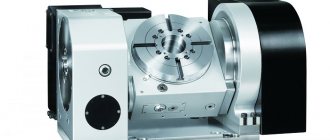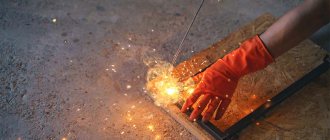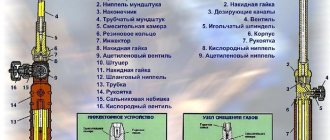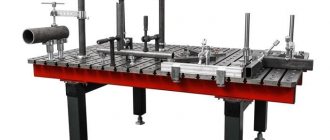Home / Accessories and parts
Back
Reading time: 2 min
0
3493
Welding work in a workshop is not like welding “on your knees” in a garage box. There, just like at home in the garden, the inverter and electrodes will go “into powder.” But in factory conditions the picture is completely different.
Special technologies and high-precision devices take welding to another level.
They ensure that the welder works in accordance with safety regulations, and the process itself proceeds faster. This is important where volume determines the employer's income. Let us characterize in more detail one of the welder’s silent assistants.
He is called a conductor, but does not cook himself. Helps ensure that welding goes without a hitch. How and what needs to be done to work without flaws?
- general characteristics
- Purpose
- Rules of circulation
- Conclusion
How to use?
The use of a conductor largely depends on the model of the device itself. But in most cases there is nothing complicated about this, everything is intuitive. If you are using a simple stationary jig table with mechanical clamps, then place the part on it and fix it in the desired position using the same clamps, stops or clamps.
If you use more technologically advanced conductors, then read the instructions for this model. Since each device may have its own nuances of use.
Regardless of the type of jig, you will most likely have to be directly involved in securing parts. Since it is you who will determine in what position this very part should be. Of course, there are also fully automated production facilities, where human work is reduced to a minimum. But it’s not just the conductors we’re talking about that are used there. High-tech units are used there.
So that the master does not have to put a lot of physical effort when fixing parts, manufacturers have provided pneumatic, hydraulic, vacuum or electromagnetic clamps. It is enough to apply a minimum of effort so that they begin their movement and fix the part.
general information
A welding jig (welding and assembly jig, assembly jig, assembly jig, welding jig, etc.) is a special device designed for fixing and pre-assembling metal structures with which you will work. With the help of an assembly jig, the parts are securely fixed in one place, it is convenient to weld them and monitor the progress of the work.
The name "welding jig" is colloquial. In professional circles and in stores, this device is called a “welding table-manipulator”. It is often used to fix the rotation of pipes, as well as other large parts. For example, metal beams. But the assembly jig can actually be used with any parts. Manufacturers produce jigs of all shapes and sizes so that you can work with parts and structures of any size. The operating principle of the conductor may differ from model to model. In some places it’s just a table with a mechanical vice that holds the part. And in some places it is a full-fledged electromechanical device capable of moving parts in a given direction. But, regardless of the model of the conductor, it will always have a rigid metal frame on which all other functionality is “strung”.
Types of auxiliary mechanisms
Various mechanisms and auxiliary parts are made at factories and at home. The simplest of them are easy to make with your own hands. In general, welding aids come in three types:
- mechanisms for installation, assembly, preliminary fixation;
- clamping devices;
- combined devices.
The first type of fixture is used to install parts in the position required for welding. Clamping welding fixtures firmly fix them and prevent them from slipping or turning. Combination devices perform both functions.
The choice of devices is related to the work conditions. It also depends on the requirements for the accuracy of manufacturing workpieces, requirements for clearances, and the design as a whole.
There are certain requirements for auxiliary devices. They must ensure free movement of the parts being welded caused by heating in the welding zone.
Homemade jig for rolling profile pipes
Using a homemade jig for rolling a profile, you can make small grooves in the profile pipe - they are needed to strengthen the pipe.
To make this device, you will need a piece of metal plate 6 mm thick, as well as two bearings with an internal diameter of 25 mm.
The first step is to cut the plate into two identical parts - the base and the cover.
Bearings are installed on the base with a gap for a 15*15 mm profile pipe. The top of the bearings must be covered with a lid.
Fasteners
Clamps include devices that ensure a stable position of the welded product. They are made in the form of pockets, stops, mounting pins, prisms and templates.
Removable stops are used in universal stands when it is necessary to adjust for a specific product, or it is impossible to remove the product without deforming it.
Fingers allow you to accurately position the workpiece; they are usually used when working with products that have machined planes. Prisms are used when welding various pipes.
Templates are a design that follows the contour of the product being welded. The parts are installed in a template, welded, and the result is identical products when the welding process is repeated. The part itself becomes the load-bearing element, and the template sets the shape.
When making a single product, sometimes fixation is required in a non-standard way. It also happens that the necessary equipment is not at hand.
In this case, the welder makes it himself from scrap materials. To make homemade welding fixtures, a few pieces of corners and a pair of clamps are enough.
With their help you can get a simple and reliable lock. If you need to get a clamp for a connection at a right angle, just weld the corners perpendicular to each other and grab them with a third corner.
By welding the clamps in the right places, a clamp is obtained for perpendicular connection of products. That is, if necessary, the welder can provide himself with the required devices.
Homemade jig for welding profile pipes
In this review, the author shows the process of making a homemade jig, which is useful when welding profile pipes.
This device simplifies the welding of profile pipes, especially if you work on your own. It's not difficult to make.
To make the conductor, you will need to cut a piece of 40*25 mm profile pipe approximately 15-16 cm long.
We make markings and cut out a square “window” in the center of the workpiece. This can be done either with a grinder or with a drill.
A “window” must also be cut out on the opposite side of the profile pipe.
Clamps and tightening devices
Clamping devices play an important role. They press workpieces to clamps or tooling planes, and are mechanical, pneumatic and magnetic.
Mechanical clamps are very simple in design, therefore they are the most common. They are reliable, rarely fail and are inexpensive. Mechanical devices are wedge, screw and spring. Wedge clamps are usually used when aligning the edges of a product, when pressing the contacting parts of the parts being welded.
But the most common and universal devices are screw clamps, they are also called clamps . They are used mostly for single production and in the household, and require a lot of installation time. Spring clamps are used when welding small and thin workpieces.
Pneumatic devices can be used as welding aids. They have high performance, are distinguished by accuracy and a “death grip”.
Main stages of work
At the next stage, the author makes rollers for rolling a profile pipe from a piece of good spring steel. You will need two pieces in total.
It will be necessary to make slots in the center of the base and cover of the device, into which rollers are then inserted for rolling the profile.
To install the rollers on the platform, the master makes special fasteners for them, which are welded to the top and bottom of the homemade product.
After this, all that remains is to weld the handle to the body. The author makes it from a hexagonal rod.
For more information on how to make a device for rolling a profile pipe with your own hands, watch the video on our website.
Source
Rotators
To rotate large structures, so-called tilters are used. They come in roller and lantern types, lever, center and chain.
Roller devices are used to rotate large cylindrical structures. They are useful in the production of circular joints; they have several rollers: one is driven, the rest are used without a drive.
To prevent slipping, the drive roller is secured with a rubber band. Appropriate mechanisms are used for turning conical parts. They have several pairs of rollers located at an angle to each other.
Lever tilters are used when turning flat parts. Centering devices are used when it is necessary to rotate the product 360 °. Chain devices are used when welding large parts of long length.
Manufacturing
To give the correct shape, the block can be ground on a belt sander.
Next, you need to mark two points, as shown in the photo below, for the through holes.
Then we drill through holes according to the marks made.
Then you need to cut off the lower part of the block at an angle of 15 degrees.
Afterwards, using liquid welding or glue, you need to glue the tubes from the anchors into the holes made as shown in the photo below.
After the glue has dried, you need to saw off the protruding parts of the tubes from the bottom flush with the block.
At this stage, the conductor can be considered complete. Of course, you can paint it for a more aesthetic look, but I haven’t done that yet.
Now you can test the conductor. We put it on a piece of chipboard, press it with a clamp and you can drill holes.
These are the holes we get.
After this, you can use self-tapping screws to fasten the two workpieces together. As practice has shown, everything holds up just fine.
Manipulators
These devices are adapted to rotate the welded product during operation. The manipulator can rotate the part in the vertical and horizontal plane, tilt it at different angles in the horizontal plane, which ensures a high-quality weld.
There are installation and welding manipulators. The first type of devices, also called positioners, installs the workpiece at the desired point and in the required position, convenient for assembly. Welding manipulators move products along a given path at the speed required for welding.
The main characteristics of manipulators are its load capacity, the maximum possible dimensions and the number of degrees of freedom of its faceplate, to which the part to be welded is attached.
In production facilities for welding work, there is usually a whole range of devices that ensure the installation of workpieces in the desired position, capable of moving them vertically and horizontally, and rotating them.
Additionally, rail tracks, trolleys and other devices are used to speed up and facilitate the welding process. Using standard, proven tools, the welding process is much faster and more efficient, although the use of homemade products never harms this.
Advantages of use in production
Welded structures have become an indispensable part of the production process. The use of assembly jigs frees the worker from the need to constantly hold the workpiece with his hands, which leads to optimization of welding work without the involvement of additional personnel.
It also provides the following benefits:
- Production processes are speeding up.
- The range of work that can be performed is expanding.
- The range of products available for manufacturing is increasing.
- It becomes possible to fulfill bulk orders.
- Materials are saved by reducing scrap.
- Profit increases.
- Safety requirements are met.
Concern for occupational safety is perhaps the main aspect of using welding devices. Without them, the task of holding workpieces is performed by an assistant, who risks severe injuries and burns. The devices completely replace the work of assistants. And in machine-building industries, welding processes are fully automated.











